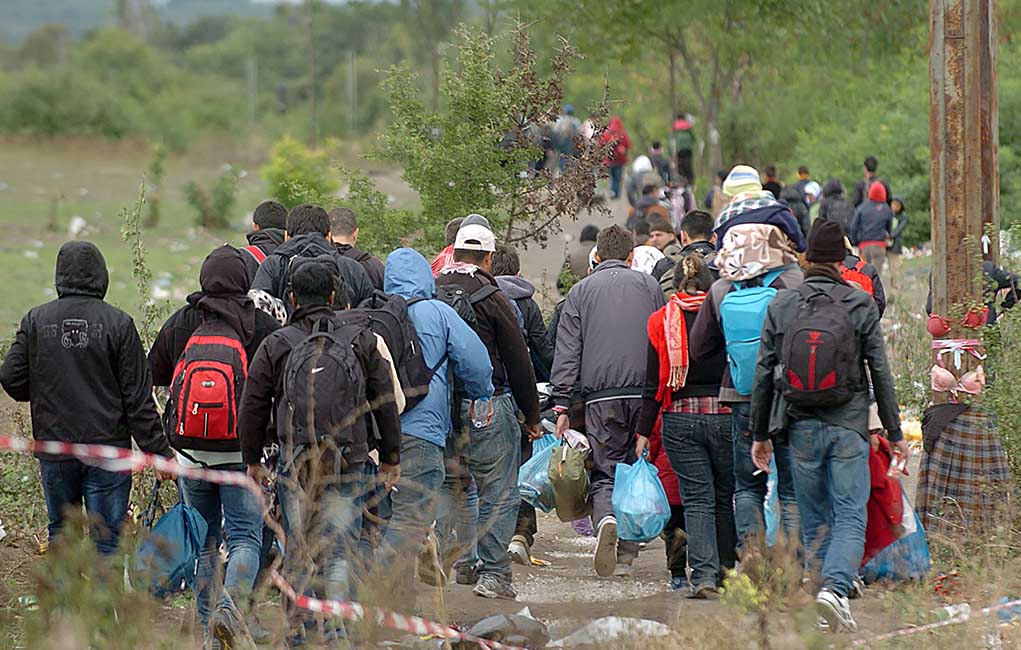China-U.S. Tariff Negotiations: Economic Pressures and De-Escalation
China confirms U.S. requested tariff talks in Switzerland, stating clearly that their position remains firm on principles of equality and mutual respect—despite both sides facing economic pressures to reduce tariffs. Top Takeaways China has confirmed upcoming trade talks on tariffs in Switzerland were requested by the United States, not China. Chinese officials insist any productive […]
Apple Settles Siri Privacy Lawsuit: Are You Eligible for Compensation?
Apple agrees to pay $95 million to settle claims that its voice assistant Siri recorded users without permission, with eligible device owners able to claim up to $100 in compensation. Top Takeaways Apple users who owned Siri-enabled devices between September 17, 2014, and December 31, 2024, may be eligible for up to $20 per device […]
Examining the Controversial $1,000 Offer for Voluntary Deportation
The Department of Homeland Security’s new proposal offers illegal immigrants $1,000 and free flights home if they voluntarily leave the United States, but critics warn the program may be a deceptive trap. Top Takeaways DHS is offering $1,000 stipends and free airfare to illegal immigrants who voluntarily deport themselves Self-deportation would be processed through a […]
Exploring the U.S. Army’s Strategic Overhaul for Improved Lethality and Efficiency
The U.S. Army is undergoing its most significant reorganization in decades, combining major commands and cutting up to 1,000 positions to create a more agile fighting force ready to face modern threats, particularly from China. Top Takeaways The Army will merge several major commands including Army Futures Command with Training and Doctrine Command, and consolidate […]
Proposal Sparks Debate Over Vaccine Trial Requirements by Robert F. Kennedy Jr.
Health Secretary Robert F. Kennedy Jr. announced plans to mandate placebo-controlled trials for all new vaccines, sparking debate between public health officials and vaccine skeptics amid ongoing measles outbreaks. Top Takeaways Kennedy proposes that all new vaccines must undergo placebo-controlled trials, potentially increasing safety transparency The Health Secretary advised parents to “do your own research” […]
Reagan Airport Collision: Unraveling New Details of Pilot Error and Safety Failures
Black Hawk helicopter pilot Captain Rebecca M. Lobach failed to follow critical instructions from her flight instructor moments before the deadly collision with an American Airlines passenger jet near Reagan National Airport that killed 67 people in January’s worst aviation disaster since 2001. Top Takeaways Captain Rebecca M. Lobach failed to execute a potentially life-saving […]
U.S. Airstrike in Yemen Sparks Controversy Over Alleged Targeting of Migrant Site
Reports from Yemen claim a U.S. airstrike has killed at least 68 people at a facility housing African migrants, escalating tensions in the ongoing conflict as the military targets Houthi rebel positions. Top Takeaways An alleged American airstrike killed at least 68 people and injured 47 others at a migrant detention center in Yemen’s Saada […]
Exploring Trump’s Call to Probe ActBlue’s Financial Methods and Alleged Fraud
President Trump has directed Attorney General Pam Bondi to investigate ActBlue for alleged fraudulent fundraising practices, setting up a major confrontation with Democrats over campaign finance integrity. Top Takeaways Trump signed a memorandum directing the Department of Justice to investigate ActBlue for alleged “straw donor” schemes and foreign contributions A House Judiciary Committee report claims […]
Why is the Trump Administration Trying to Block this Illegal Immigrant’s Early Release?
The Trump administration has launched an aggressive effort to block the early release of Oscar Eduardo Ortega-Anguiano, an illegal immigrant who killed two teenagers while driving drunk, as California Governor Gavin Newsom agrees to cooperate with federal authorities seeking additional charges. Top Takeaways Ortega-Anguiano, previously deported in 2013, was sentenced to 10 years for killing […]
Abbas’ Bold Language: Will Calls for Disarmament Lead to Palestinian Unity?
Palestinian Authority President Mahmoud Abbas lashed out at Hamas with unprecedented fury, calling them “sons of dogs” and demanding they disarm, release hostages, and cede control of Gaza to end the devastating conflict with Israel. Top Takeaways Abbas delivered his harshest criticism of Hamas since the war began, using the derogatory term “sons of dogs” […]
New Security Measures and Detention Powers Enacted at New Mexico Border
U.S. military granted unprecedented authority to detain migrants on New Mexico border as Trump administration expands border security operations. Top Takeaways A 60-foot-wide zone along the New Mexico-Mexico border has been designated as part of Arizona’s Fort Huachuca, giving the military new detention powers. U.S. Northern Command can now search, detain, and provide medical assistance […]
Senator Warnock’s Luxurious Atlanta Home Sparks Ethics Concerns
Senator Raphael Warnock faces scrutiny over living rent-free in a church-purchased luxury home valued at nearly $1 million while his church simultaneously evicts low-income tenants for minor rent delinquencies. Top Takeaways Senator Warnock has been living rent-free since 2023 in a luxury home valued at $989,000 that was purchased by Ebenezer Baptist Church, where he […]
Judge Takes Aim at Google’s Digital Ad Monopoly Practices
A federal judge has ruled that Google illegally maintains monopolies in digital advertising technology, opening the door for a potential forced breakup of the tech giant’s advertising business. Top Takeaways U.S. District Judge Leonie Brinkema found Google guilty of maintaining illegal monopolies in publisher ad servers and ad exchanges The ruling allows the Justice Department […]
Salvadoran Deportation Case: Migrant’s MS-13 Links Spark Debate
The battle over Salvadoran migrant Kilmar Abrego Garcia’s deportation reveals deep divisions as DHS insists he’s an MS-13 gang member, while Democrats call his removal a “kidnapping” and his lawyers maintain his innocence. Top Takeaways Abrego Garcia was deported to El Salvador due to an “administrative error” according to the government, but DHS maintains he […]
Controversial Allegations of Mortgage Fraud Emerge Against NY Attorney General
New York Attorney General Letitia James faces serious mortgage fraud allegations as the Federal Housing Finance Agency refers her case to the Department of Justice for potential criminal prosecution. Top Takeaways The Federal Housing Finance Agency (FHFA) has sent a criminal referral to the Department of Justice alleging mortgage fraud by New York Attorney General […]
American Pastor’s South African Saga Unveils Mission Work Dangers
American pastor Josh Sullivan’s harrowing kidnapping in South Africa ended with a dramatic police rescue operation that left three captors dead following an intense shootout. Top Takeaways Tennessee pastor Josh Sullivan was rescued unharmed after being abducted at gunpoint during a prayer meeting at his church in South Africa on April 10. The rescue operation […]
New Global Payment System Proposed: A Challenger to SWIFT?
BRICS nations unveil plans for an alternative payment system that could undermine the Western financial dominance established through SWIFT and the US dollar. Top Takeaways BRICS Pay was introduced at the summit in Kazan, Russia, designed as a decentralized platform to challenge SWIFT’s global monopoly The initiative gained momentum after sanctions on Russia exposed vulnerabilities […]
What’s Inside the New US Military Agreement With Panama?
The US and Panama have reportedly agreed to allow American troops near the Panama Canal for training exercises, sparking debate over security cooperation versus national sovereignty in this strategic waterway. Top Takeaways A memorandum of understanding allows US troops to be stationed along the Panama Canal for training and military exercises, but without permanent bases […]
Fire Breaks Out at Governor’s Residence: Investigation Underway
Pennsylvania Governor Josh Shapiro and his family were forced to evacuate their residence early Sunday morning after an arsonist set fire to the property while they slept. Top Takeaways Pennsylvania State Police have confirmed the incident was an act of arson that caused significant damage to the governor’s residence in Harrisburg. The Shapiro family was […]
Pentagon Alert: Unseen Developments in Russian Space Activities Uncovered
A mysterious object released from Russian military satellites has triggered Pentagon alarm bells as tensions over space militarization escalate between global powers. Top Takeaways The U.S. Space Force has detected a mystery object released from one of three Russian military satellites (Kosmos 2581, 2582, and 2583) orbiting Earth at approximately 364 miles altitude. Russia has […]
France’s Bold Move for Stability: A New Path to Peace in the Middle East?
France is preparing to officially recognize a Palestinian state within months, potentially reshaping Middle East peace negotiations as President Emmanuel Macron advances his diplomatic agenda despite potential fallout with Israel. Top Takeaways France plans to recognize a Palestinian state as early as June 2025, potentially becoming the most significant European power to do so Macron […]
No Rogue Rulings Act: What Are the Implications of Congress Curbing Judicial Powers?
House Republicans pushed through a bill limiting judicial authority to block presidential actions, setting the stage for a contentious Senate battle that could significantly impact the balance of power between branches of government. Top Takeaways The House passed a bill (219-213) that would prevent federal district judges from issuing nationwide injunctions The legislation limits judges […]
China’s Response to U.S. Tariffs: A Growing Divide in Global Trade?
China slaps 84% tariff hike on US goods as President Trump’s 104% tariffs take effect, plunging both economic superpowers into an escalating trade war with potentially far-reaching global consequences. Top Takeaways China has retaliated against Trump’s 104% tariffs by increasing duties on US goods to 84% and filing a complaint with the WTO. Beijing is […]
Underwater Espionage: New Threats Loom Over Britain’s Seas
Russian spy sensors detected in British waters have sparked national security concerns as evidence mounts of a covert underwater espionage campaign threatening critical infrastructure. Top Takeaways Multiple Russian spy sensors targeting UK’s nuclear-armed submarines have been discovered in British waters Britain is reportedly “behind the curve” in tracking Russia’s expanding deep-sea espionage operations Critical underwater […]
Evaluating the Strategic and Financial Effects of U.S. Actions in Yemen
President Trump’s “Operation Rough Rider” has already cost American taxpayers $200 million in just three weeks of bombing Houthi militants in Yemen, with Pentagon officials privately admitting the campaign has shown limited effectiveness despite the massive price tag. Top Takeaways The U.S. bombing campaign against Houthi militants in Yemen has cost $200 million in munitions […]
Rising Cross-Border Strains: U.S. Allies On A Collision Course In Syria
Israel launches surgical strikes on Syrian military airfields in a direct warning to Turkey as President Erdogan attempts to expand his influence in the region and reshape the Middle East power balance. Top Takeaways Israel targeted Syrian military airports to prevent Turkey from interfering with Israeli operations in Syrian airspace Turkey’s attempts to expand military […]
Governor Stops Islamic Community Project Over Legal and Community Disputes
Governor Greg Abbott has halted a controversial plan for a Muslim-focused community near East Plano, citing legal concerns and initiating investigations by multiple state agencies as tensions rise over allegations of Sharia law implementation. Top Takeaways Texas Governor Greg Abbott ordered 12 state agencies to investigate the proposed “EPIC City” development, citing permit violations and […]
Journalist Files Massive Defamation Lawsuit Against Politician Over Allegations
Journalist Matt Taibbi files $10 million defamation lawsuit against Congresswoman Sydney Kamlager-Dove after she publicly labeled him a “serial sexual harasser” during a congressional hearing, setting the stage for a high-stakes battle over truth and reputation. Top Takeaways Matt Taibbi has filed a $10 million libel lawsuit against Rep. Sydney Kamlager-Dove for calling him a […]
Cross-Border Environmental Challenge: The Impact of the Tijuana River Issues
Mexico plans to dump 400 million gallons of raw sewage into the Tijuana River, threatening U.S. communities with toxic waste while federal authorities have yet to declare an emergency despite years of pollution. Top Takeaways Mexico is set to release approximately 400 million gallons of untreated sewage into the Tijuana River that will flow directly […]
Urgent Pleas for Justice After Massacre of Aid Workers
The mysterious deaths of 14 aid workers in Khan Younis, Gaza, have sparked international outcry and demands for a thorough investigation, with forensic evidence suggesting execution-style killings at the hands of Israeli forces. Top Takeaways 14 humanitarian workers, including paramedics and Civil Defense members, were found dead in a mass grave near Rafah, Gaza, with […]






























